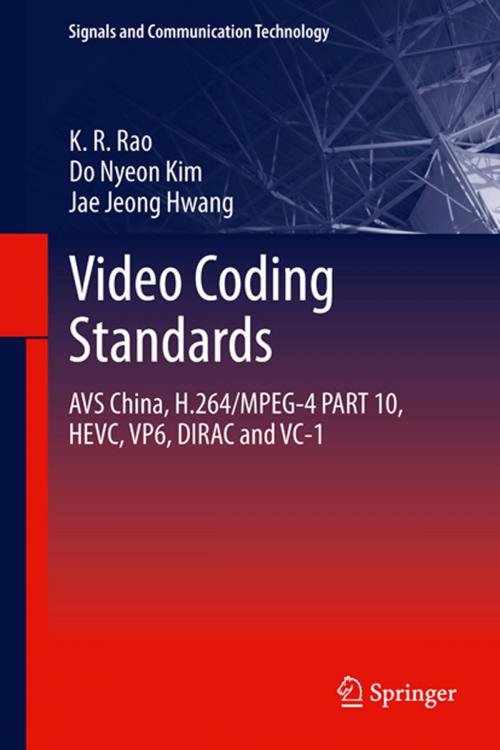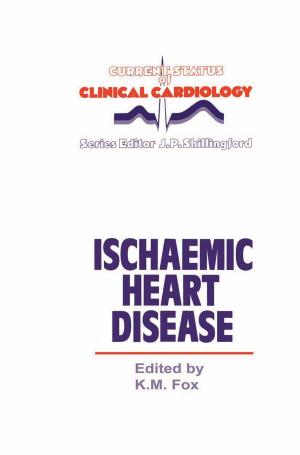Video coding standards
AVS China, H.264/MPEG-4 PART 10, HEVC, VP6, DIRAC and VC-1
Nonfiction, Science & Nature, Technology, Telecommunications, Science, Physics, General Physics| Author: | K.R. Rao, Jae Jeong Hwang, Do Nyeon Kim | ISBN: | 9789400767423 |
| Publisher: | Springer Netherlands | Publication: | October 7, 2013 |
| Imprint: | Springer | Language: | English |
| Author: | K.R. Rao, Jae Jeong Hwang, Do Nyeon Kim |
| ISBN: | 9789400767423 |
| Publisher: | Springer Netherlands |
| Publication: | October 7, 2013 |
| Imprint: | Springer |
| Language: | English |
The requirements for multimedia (especially video and audio) communications increase rapidly in the last two decades in broad areas such as television, entertainment, interactive services, telecommunications, conference, medicine, security, business, traffic, defense and banking. Video and audio coding standards play most important roles in multimedia communications. In order to meet these requirements, series of video and audio coding standards have been developed such as MPEG-2, MPEG-4, MPEG-21 for audio and video by ISO/IEC, H.26x for video and G.72x for audio by ITU-T, Video Coder 1 (VC-1) for video by the Society of Motion Picture and Television Engineers (SMPTE) and RealVideo (RV) 9 for video by Real Networks.
AVS China is the abbreviation for Audio Video Coding Standard of China. This new standard includes four main technical areas, which are systems, video, audio and digital copyright management (DRM), and some supporting documents such as consistency verification. The second part of the standard known as AVS1-P2 (Video - Jizhun) was approved as the national standard of China in 2006, and several final drafts of the standard have been completed, including AVS1-P1 (System - Broadcast), AVS1-P2 (Video - Zengqiang), AVS1-P3 (Audio - Double track), AVS1-P3 (Audio - 5.1), AVS1-P7 (Mobile Video), AVS-S-P2 (Video) and AVS-S-P3 (Audio). AVS China provides a technical solution for many applications such as digital broadcasting (SDTV and HDTV), high-density storage media, Internet streaming media, and will be used in the domestic IPTV, satellite and possibly the cable TV market. Comparing with other coding standards such as H.264 AVC, the advantages of AVS video standard include similar performance, lower complexity, lower implementation cost and licensing fees. This standard has attracted great deal of attention from industries related to television, multimedia communications and even chip manufacturing from around the world. Also many well known companies have joined the AVS Group to be Full Members or Observing Members. The 163 members of AVS Group include Texas Instruments (TI) Co., Agilent Technologies Co. Ltd., Envivio Inc., NDS, Philips Research East Asia, Aisino Corporation, LG, Alcatel Shanghai Bell Co. Ltd., Nokia (China) Investment (NCIC) Co. Ltd., Sony (China) Ltd., and Toshiba (China) Co. Ltd. as well as some high level universities in China. Thus there is a pressing need from the instructors, students, and engineers for a book dealing with the topic of AVS China and its performance comparisons with similar standards such as H.264, VC-1 and RV-9.
The requirements for multimedia (especially video and audio) communications increase rapidly in the last two decades in broad areas such as television, entertainment, interactive services, telecommunications, conference, medicine, security, business, traffic, defense and banking. Video and audio coding standards play most important roles in multimedia communications. In order to meet these requirements, series of video and audio coding standards have been developed such as MPEG-2, MPEG-4, MPEG-21 for audio and video by ISO/IEC, H.26x for video and G.72x for audio by ITU-T, Video Coder 1 (VC-1) for video by the Society of Motion Picture and Television Engineers (SMPTE) and RealVideo (RV) 9 for video by Real Networks.
AVS China is the abbreviation for Audio Video Coding Standard of China. This new standard includes four main technical areas, which are systems, video, audio and digital copyright management (DRM), and some supporting documents such as consistency verification. The second part of the standard known as AVS1-P2 (Video - Jizhun) was approved as the national standard of China in 2006, and several final drafts of the standard have been completed, including AVS1-P1 (System - Broadcast), AVS1-P2 (Video - Zengqiang), AVS1-P3 (Audio - Double track), AVS1-P3 (Audio - 5.1), AVS1-P7 (Mobile Video), AVS-S-P2 (Video) and AVS-S-P3 (Audio). AVS China provides a technical solution for many applications such as digital broadcasting (SDTV and HDTV), high-density storage media, Internet streaming media, and will be used in the domestic IPTV, satellite and possibly the cable TV market. Comparing with other coding standards such as H.264 AVC, the advantages of AVS video standard include similar performance, lower complexity, lower implementation cost and licensing fees. This standard has attracted great deal of attention from industries related to television, multimedia communications and even chip manufacturing from around the world. Also many well known companies have joined the AVS Group to be Full Members or Observing Members. The 163 members of AVS Group include Texas Instruments (TI) Co., Agilent Technologies Co. Ltd., Envivio Inc., NDS, Philips Research East Asia, Aisino Corporation, LG, Alcatel Shanghai Bell Co. Ltd., Nokia (China) Investment (NCIC) Co. Ltd., Sony (China) Ltd., and Toshiba (China) Co. Ltd. as well as some high level universities in China. Thus there is a pressing need from the instructors, students, and engineers for a book dealing with the topic of AVS China and its performance comparisons with similar standards such as H.264, VC-1 and RV-9.















